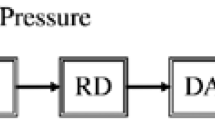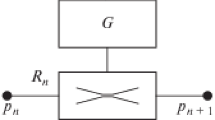Abstract
Two simple and inexpensive methods for dynamic calibration of manometer systems for the clinical environment are described. One is a modification of a well known step-function technique, the other is a sinusoidal pressure generator using magnetic fluids. The practical use of both methods is described in detail, and a test of the accuracy of the methods is made. In particular, it is found that both methods are useful in the frequency range of at least 0 to 100 Hz, and that resonance frequencies could be determined with an error of about±5%, whereas the error in damping factor is greater, of the order of ±50%. The step-function technique is quicker and easier to apply under sterile conditions and is therefore recommended for wider use.
Sommaire
L'article décrit deux méthodes simples et non coûteuses de calibration dynamique des systèmes manométriques, applicables dans les milieux cliniques. La première est une modification d'une technique de fonction en échelon bien connue et la seconde est un générateur de pression sinusoïdale à partir de fluides magnétiques. L'usage pratique des deux méthodes est décrit en détail et des essais sur leur précisions sont effectués. On trouve en particulier que les deux méthodes sont pratiques dans la zone allant de 0 à 100 Hz au moins et que les fréquences de résonance peuvent être déterminées avec une erreur d'environ ±5% alors que l'erreur du facteur d'atténuation est plus élevée, de l'ordre de ±50%. La technique de la fonction en échelon est plus rapide et plus simple à utiliser sous milieu ambiant stérile, son usage est donc recommandé dans un plus grand nombre de cas.
Zusammenfassung
Zwei einfache, billige Verfahren zur dynamischen Eichung von Manometersystemen für den klinischen Gebrauch werden beschrieben. Das eine ist eine Abänderung eines wohlbekannten Stufenfunktionsverfahrens, das andere ist ein sinusähnlicher Druckgenerator mit Magnetflüssigkeiten. Die praktische Anwendung beider Verfahren wird genau beschrieben, und die Genauigkeit der Verfahren wird geprüft. Insbesondere wird festgestellt, daß beide Verfahren im Frequenzbereich von wenigstens 0 bis 100 Hz nütxlich sind und daß Resonanzfrequenzen mit einer Regelabweichung von etwa±5% bestimmt werden könnten, wogegen die Regelabweichung im Schwächungsfaktor größer ist, d.h. bei ±50% liegt. Das Stufenfunktionsverfahren ist schneller und leichter unter sterilen Bedingungen anzuwenden und wird daher für einen Gebrauch in größerem Umfang emfohlen.
Similar content being viewed by others
References
Ball, G. andGabe, I. (1963) Sinusoidal pressure generator for testing differential manometers.Med. Electron. Biol. Eng. 1, 237–241.
Hansen, A. T. (1949) Pressure measurement in the human organism.Acta Physiol. Scand. 19, Suppl. 68, 7–230.
Henry, W. L., Wilner, B. andHarrison, D. C. (1967) A calibrator for detecting bubbles in cardiac catheter-manometer systems.J. Appl. Physiol. 23, 1007–1009.
Hök, B. (1975) New microtransducer for physiological pressure recordings.Med. and Biol. Eng. 13, 279–284.
Krovetz, L. J. andGoldbloom, S. D. (1974) Frequency content of intravascular and intracardiac pressures and their time derivatives.IEEE Trans. Biomed. Eng. BME-21, 498–501.
McDonald, D. A. (1974)Blood flow in arteries, 2nd ed. Edward Arnold, London.
Noble, F. W. (1959) A hydraulic pressure generator for testing the dynamic characteristics of blood pressure manometers.J. Lab. & Clin. Med. 54, 897–902.
Shelton, C. D. andWatson, B. W. (1968) A pressure generator for testing the frequency response of catheter-transducer systems used for physiological pressure measurements.Phys. Med. Biol. 13, 523–528.
Stegall, H. F. (1967) A simple, inexpensive, sinusoidal pressure generator.J. Appl. Physiol. 22, 591–592.
Vierhout, R. R. andVendrik, A. J. H. (1961) A hydraulic pressure generator for testing the dynamic characteristics of catheters and manometers.J. Lab. Clin. Med. 58, 330–333.
Vierhout, R. R. andVendrik, A. J. H. (1964) On pressure generators for testing catheter manometer systems.Phys. Med. Biol. 10, 403–406.
Yanof, H. M., Rosen, A. L., McDonald, N. M. andMcDonald, D. A. (1963) A critical study of the response of manometers to forced oscillations.Phys. Med. Biol. 8, 407–422.
Author information
Authors and Affiliations
Additional information
The work was carried out at the Electronics Department, Institute of Technology, University of Uppsala
Rights and permissions
About this article
Cite this article
Hök, B. Dynamic calibration of manometer systems. Med. & biol. Engng. 14, 193–198 (1976). https://doi.org/10.1007/BF02478747
Received:
Accepted:
Issue Date:
DOI: https://doi.org/10.1007/BF02478747




